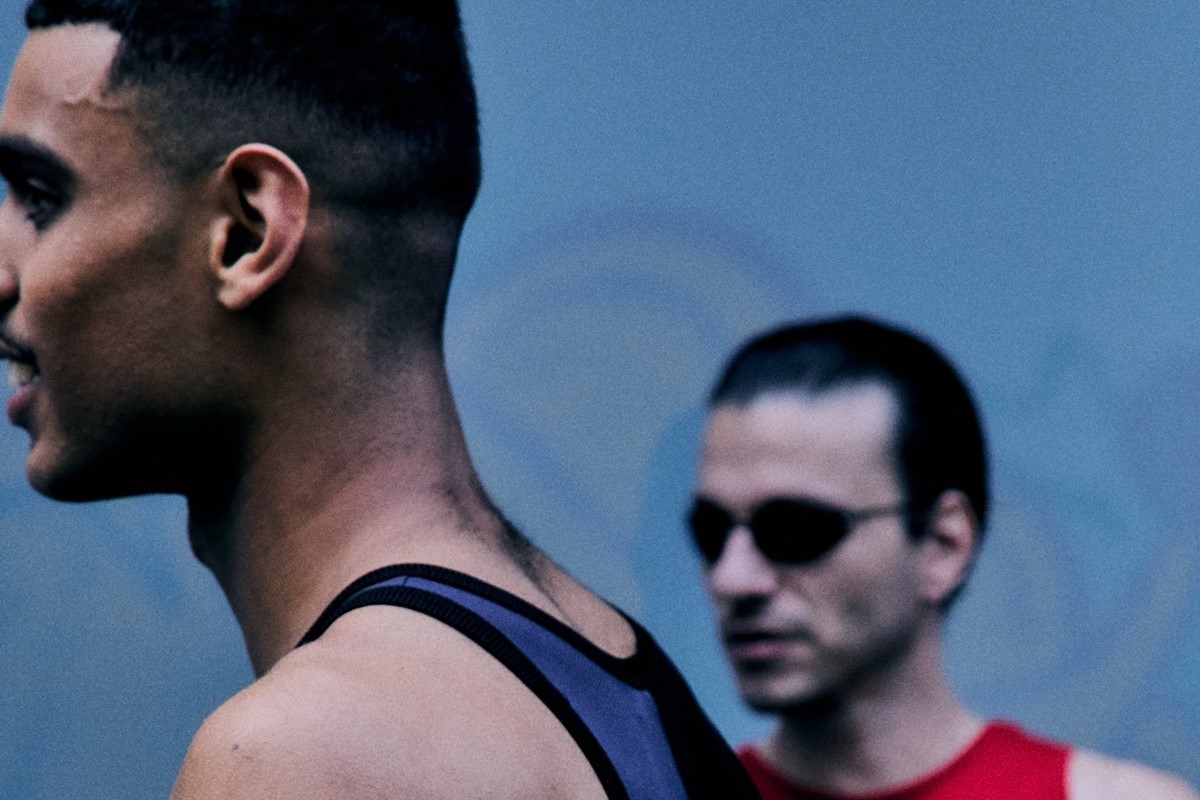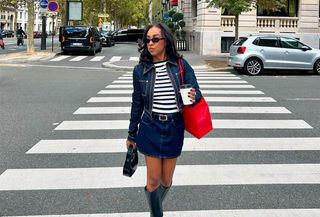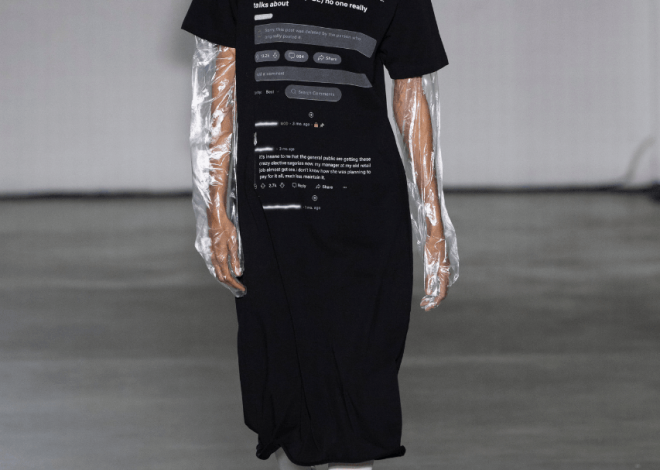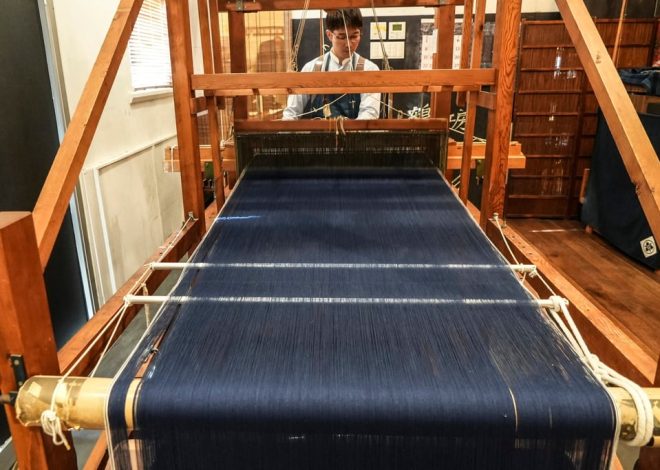
The Very Best Shows From Berlin Fashion Week
July 11, 2024
Lead ImageGmbH Spring/Summer 2025Photography by Harry Miller
Everyone’s got some preconceptions about fashion in Berlin (the city‘s style is so distinct that even the word ‘Berlin’ is now used as an adjective). A seatmate at a particularly ‘Berlin’ show (before they’d just flashed questionable slogan vests) told me, “A lot of the fashion brands in Europe are trying to be ‘Berlin’. Berlin’s trying to be Berlin, too.” It’s a polite way of suggesting it’s a little clichéd, which is true to an extent. There’s a self-contained reference pool drawn from those throbbing dark alleys and tobacco-tinged warehouses, but as a national uniform for the city’s young, hardcore bon vivants, the red and black leather and latex looks pretty fantastic. At the afterparties – of which there were many – I started wishing I was a little more ‘Berlin’ too.
The schedule for day one of Berlin Fashion Week was populated by designers with a global reach thanks to the Reference Studio’s Intervention platform, which is now in its second edition. “The designers that I chose represent the whole bandwidth of Berlin, across age groups, ethnicities, design methods or aesthetics, and of course points of reference,” says Mumi Haiati, the founder of the communication agency and curator of the week. These included Shayne Oliver’s Anonymous Group, GmbH, Lueder, Dzhus and more. “What connects them all probably is their authenticity and strong community focus.” Taking place at the legendary Tempodrom, which once started with a circus tent on Potsdamer Platz in 1980 and now operates as a performance venue, the setting speaks to the city’s ties to music and culture.
It’s exciting to experience Berlin across these five days, and there’s a feeling that things are just getting started for many of these brands. It’s a bit like how London felt ten years ago – a little bit rebellious, anti-establishment, with two fingers up to the status quo. Haiati agrees: “I think it was this very special, creative energy about London that made it so exciting. I am glad Berlin seems to feel like that now. It also comes as an exciting challenge to maintain, nourish, and build on this energy to create lasting opportunities for our designers.” The opportunity to grow these designers is backed by politicians who hope to bolster the region’s creative scene, with state-run competitions like Berlin Contemporary offering 25,000 euros for the top 16 show concepts. The level of support is excellent – other cities should take heed.
Below, we list six of the best shows from July’s Berlin Fashion Week 2024.
Shayne Oliver has still got it. The fashion industry wept when his most famous project, Hood By Air, went on hiatus in 2017, having spent a little over a decade shaking up fashion far beyond its streetwear roots. He went in-house at a few houses including Helmut Lang and Diesel, before opening Anonymous Club in 2020 as a slightly confusing ‘collective studio’ to shelter him from being the label’s sole figurehead, giving him a level of ambiguity. Presented at Tempodrom as part of Reference Studios’ Intervention II, where gaggles of lanky, uber-cool kids funnelled into the concrete circular auditorium for the evening show, this was the second outing for his still-budding project. Considering the designer’s newfound industry reticence, the collective thirst for more felt palpable.
To the best soundtrack of the week, (as well as an unreleased track from Kanye West, who also allegedly hosted Oliver’s afterparty at Soho House Berlin later that evening), the collection, titled Freudian Glitch: Fantasia 2024, was a surrealist take on space-age-inspired streetwear. A hunched and hooded silhouette dominated the parade. Eliminating the neckline, this shape flittered between modern and menacing, while the wearer is cocooned and protective in its soft textile. Oliver’s subversive use of latex offered a darker edge.
Go behind the scenes with a photo essay by Harry Miller here.
Aptly titled Resistance Through Rituals, models trudged through pouring rain on the slippery roof of Berlin’s Tempodrom for GmbH’s Spring/Summer 2025 collection, which celebrated the brave communities that have been bound together in the wake of recent political agonies: namely, the queer communities struggling against increasingly far-right authorities, and the immigrant artists being censored in Germany due to their criticism of Israel’s acts of genocide. “Now, more than ever, it’s important to show our culture and community in Berlin, our hometown,” GmbH co-founder Benjamin Alexander Huseby told us. With slick tailoring that featured boxing-style hoods, tactical bomber jackets, itty-bitty shorts with Muay Thai elastic waistbands and asymmetrical dresses with Marvel-esque sleeves that plumed from the wrist, each look came imbued with a warrior preparedness – not only to defend, but to fight – pumped through the carnal frisson of the throbbing Berlin party scene where the brand was born.
Read AnOther’s interview with Benjamin Alexander Huseby and Serhat Işık of GmbH here.
Nothing brings drama like a fucking massive airplane. Presented in Hangar 6 of Tempelhof Airport, Berlin Contemporary winners Julius Weissenborn and Johann Ehrhardt looked to Amelia Earhart for a co-ed collection of flight gear reimagined as an urban uniform. As many of these old-school uniforms used to be, the shapes were sexy and menacing, as they swaggered around a vintage fighter plane as if ready for combat. Bombers – lots of them – were draped and reimagined, worn with leather aviator caps, neckerchiefs and high-waisted trousers. Leather trenches added that edgy nod to the city from where Haderlump hails, aided by a soundscape that seemed to throb even louder in a desolate hangar. A tasselled corset might make for a wildly inappropriate flying uniform, but Haderlump made a convincing case to take flight in their sexed-up soldering of street and sky.
SF1OG took a risk with their location this season. It was a little over an hour’s drive to the historic Umspannwerk in Reinickendorf from central Berlin, driving a wrecking ball through hopes of attending shows on either side of the schedule. Transforming the disused electrical substation into a bustling marketplace, complete with white market stalls to match the rough, chalky interior, the raw beauty of the setting alone was well worth the trek. To the sounds of local rock band Golden Hours, out came an intricate, styled-to-perfection assemblage of luxe menswear in fresh hues of pink, blue and green. The mixture of unique and adverse textiles proved to be the most interesting part, utilising mostly deadstock and antique recycled fabrics, including linen from the 19th century which echoed the marketplace setting. The all-white closing look consisted of a crocheted vest, some tactical antique linen trousers, and a durag that fell into a train, trailing metres behind. A surprising level of craftsmanship made this show a must-see, and an exciting addition to the contemporary Berlin fashion scene.
There was magical modern alchemy at play from the outset of Marie Lueder’s S/S25 show, as guests sat in a circle watching a vaping trickster dressed in hooded casuals perform an elaborate show that filled the Tempodrom venue with hazy smog. In a palette that drew from the colours of fire, ash, wood and greenery, the collection saw carefully manufactured twists on classic denim and jersey pieces, beautifully draped dresses and new adaptions of her signature ribbing techniques, constructed with her free-spirited wearer in mind. “I realised that I wanted to care for and support people through garments,” Lueder told AnOther previously. “It’s a [vehicle through which to] express myself and reach people, and it’s also very tactile and intimate.”
Having been born and raised in Sauerland in rural Germany, designer Mario Keine is well-acquainted with the area’s eccentric traditions and the uniforms that they comprise. This includes Schützenfest, a marksmen’s festival for which members of the local shooting fraternities attempt to gun down a wooden bird hung up on a pole, followed by the crowning of the Schützenkönig (marksman’s king). Whacky as they are, Keine witnessed the exclusionary nature of the festival, neglecting the admission of women and marginalised groups, and through his S/S25 collection reimagined the festival’s rituals through a queer lens, blending the masculine and feminine through his soft use of colour and decorative silhouettes. Amidst all of the raucous rave-ready numbers presented elsewhere in Berlin, Marke’s presentation felt fresh and inviting. Keine’s brand has only been up and running since 2021, and he’s already proving himself as one to watch.


